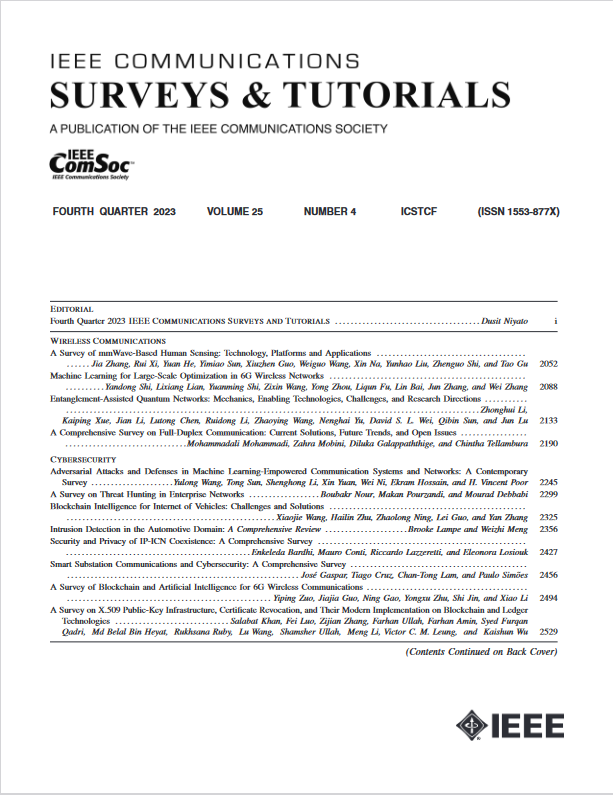An Overview on IEEE 802.11bf: WLAN Sensing
IF 34.4
1区 计算机科学
Q1 COMPUTER SCIENCE, INFORMATION SYSTEMS
引用次数: 0
Abstract
With recent advancements, the wireless local area network (WLAN) or wireless fidelity (Wi-Fi) technology has been successfully utilized to realize sensing functionalities such as detection, localization, and recognition. However, the WLANs standards are developed mainly for the purpose of communication, and thus may not be able to meet the stringent requirements for emerging sensing applications. To resolve this issue, a new Task Group (TG), namely IEEE 802.11bf, has been established by the IEEE 802.11 working group, with the objective of creating a new amendment to the WLAN standard to meet advanced sensing requirements while minimizing the effect on communications. This paper provides a comprehensive overview on the up-to-date efforts in the IEEE 802.11bf TG. First, we introduce the definition of the 802.11bf amendment as well as its formation and standardization timeline. Next, we discuss the WLAN sensing use cases with the corresponding key performance indicator (KPI) requirements. After reviewing previous WLAN sensing research based on communication-oriented WLAN standards, we identify their limitations and underscore the practical need for the new sensing-oriented amendment in 802.11bf. Furthermore, we discuss the WLAN sensing framework and procedure used for measurement acquisition, by considering both sensing at sub-7GHz and directional multi-gigabit (DMG) sensing at 60 GHz, respectively, and address their shared features, similarities, and differences. In addition, we present various candidate technical features for IEEE 802.11bf, including waveform/sequence design, feedback types, as well as quantization and compression techniques. We also describe the methodologies and the channel modeling used by the IEEE 802.11bf TG to evaluate the alternative performance. Finally, we discuss the challenges and future research directions to motivate more research endeavors towards this field in detail.IEEE 802.11bf: WLAN传感技术综述
随着最近的进步,无线局域网(WLAN)或无线保真度(Wi-Fi)技术已成功地用于实现检测、定位和识别等传感功能。然而,无线局域网标准主要是为了通信目的而制定的,因此可能无法满足新兴传感应用的严格要求。为了解决这一问题,IEEE 802.11工作组成立了一个新的任务组(TG),即IEEE 802.11bf,其目标是对WLAN标准进行新的修订,以满足高级传感要求,同时最大限度地减少对通信的影响。本文提供了IEEE 802.11bf TG最新工作的全面概述。首先,我们介绍了802.11bf修正案的定义以及它的形成和标准化时间表。接下来,我们将讨论具有相应关键性能指标(KPI)需求的WLAN传感用例。在回顾了以前基于面向通信的WLAN标准的WLAN传感研究之后,我们确定了它们的局限性,并强调了802.11bf中新的面向传感修正的实际需求。此外,我们讨论了用于测量采集的WLAN传感框架和程序,分别考虑了低于7ghz的传感和60 GHz的定向多千兆(DMG)传感,并讨论了它们的共同特征、相似性和差异。此外,我们提出了IEEE 802.11bf的各种候选技术特征,包括波形/序列设计,反馈类型以及量化和压缩技术。我们还描述了IEEE 802.11bf TG用于评估替代性能的方法和信道建模。最后,我们详细讨论了该领域面临的挑战和未来的研究方向,以激励更多的研究努力。
本文章由计算机程序翻译,如有差异,请以英文原文为准。
求助全文
约1分钟内获得全文
求助全文
来源期刊

IEEE Communications Surveys and Tutorials
COMPUTER SCIENCE, INFORMATION SYSTEMS-TELECOMMUNICATIONS
CiteScore
80.20
自引率
2.50%
发文量
84
审稿时长
6 months
期刊介绍:
IEEE Communications Surveys & Tutorials is an online journal published by the IEEE Communications Society for tutorials and surveys covering all aspects of the communications field. Telecommunications technology is progressing at a rapid pace, and the IEEE Communications Society is committed to providing researchers and other professionals the information and tools to stay abreast. IEEE Communications Surveys and Tutorials focuses on integrating and adding understanding to the existing literature on communications, putting results in context. Whether searching for in-depth information about a familiar area or an introduction into a new area, IEEE Communications Surveys & Tutorials aims to be the premier source of peer-reviewed, comprehensive tutorials and surveys, and pointers to further sources. IEEE Communications Surveys & Tutorials publishes only articles exclusively written for IEEE Communications Surveys & Tutorials and go through a rigorous review process before their publication in the quarterly issues.
A tutorial article in the IEEE Communications Surveys & Tutorials should be designed to help the reader to become familiar with and learn something specific about a chosen topic. In contrast, the term survey, as applied here, is defined to mean a survey of the literature. A survey article in IEEE Communications Surveys & Tutorials should provide a comprehensive review of developments in a selected area, covering its development from its inception to its current state and beyond, and illustrating its development through liberal citations from the literature. Both tutorials and surveys should be tutorial in nature and should be written in a style comprehensible to readers outside the specialty of the article.
 求助内容:
求助内容: 应助结果提醒方式:
应助结果提醒方式:


